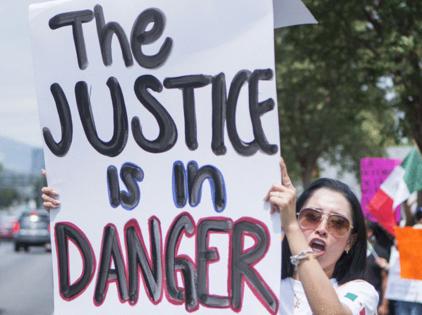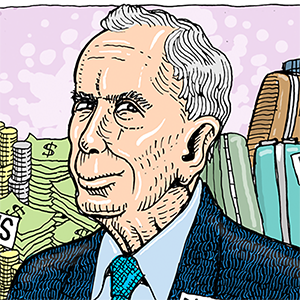Mexico's judicial reform is now in the hands of confused voters
Published in News & Features
MEXICO CITY — It’s an election unlike any other in Mexico. No sports stadiums packed with the party faithful. The smiling faces of normally omnipresent candidates almost completely absent on TV or glitzy posters. But the stakes couldn’t be higher.
On Sunday, Mexicans will begin electing judges from among thousands of largely unknown candidates in a vote critics slam as a radical experiment that will mark the end of an independent judiciary.
But Mexico’s popular President Claudia Sheinbaum, a staunch defender of the election, dismisses the naysayers. She argues the first-of-its-kind election will deepen democracy by transforming the country’s courts with jurists trusted by ordinary Mexicans. She insists it will root out corruption and nepotism.
The sheer complexity of the vote — featuring at least six color-coded ballots presenting each voter with around 200 hopefuls to consider — promises a more politicized federal judiciary. Skeptics fear it will tilt the courts toward Sheinbaum’s populist Morena Party, or in some cases install judges beholden to powerful drug cartels. Companies fret it will make investments much riskier.
Nationwide, there are more than 3,000 candidates competing for 881 positions.
Last year, as it became clear Morena would enact the judicial overhaul, Mexican assets and the peso currency nosedived.
The revamped system will see Mexico join Bolivia as the only other country in the Americas that elects its federal judges, including Supreme Court justices. In the U.S., only some state and local judges are chosen by voters.
By law, the sea of candidates can’t finance their campaigns with private or public funds, or buy television or radio spots. Parties are also banned from formally backing their favorites and candidates can’t hold traditional rallies. Instead, they’re limited to social media posts and paying out-of-pocket for travel. It’s led to an extremely low-information election.
“I didn’t know there was an election and I don’t know the candidates. I still don’t know if I’ll participate,” said Rocio Catalina, a 64-year-old in Iztapalapa, Mexico City’s most populous district. She described the looming election as “very complicated.”
In a normal election, her neighborhood would have been hit by a tidal wave of campaign posters and brochures doled out by party workers. Not this time.
Still, many would-be judges have made the most of limited means to reach voters.
Walk to a local market, and you might find a future Supreme Court justice with a megaphone touting her experience. Log on to X or TikTok, and you can watch other aspiring judges dancing in the street. Until recently, you could even find a candidate sweet-talking you on Tinder.
Designed by Sheinbaum’s party as a way to rid the courts of judges it accused of improperly blocking major initiatives, the imminent upheaval was muscled through Congress late last year thanks to the congressional super-majorities that were swept to power along with her.
With just days to go before the election, voters say they have never heard of most of the 3,000-plus hopefuls.
‘Justice Chicharrón’
If politicians are trained in the art of winning over hearts, judges usually aren’t. Campaign strategists offered package deals to promote the ambitions of aspiring judges. Discounts were available for those who accepted multitasking managers juggling a dozen campaigns at once.
One candidate compares himself to a crunchy street snack resembling fried pork in a pun-filled video touting his qualifications, and was later dubbed “Justice Chicharrón” online. Another named herself “Dora the Transformer,” after the Nickelodeon heroine but also a nod to the political project Sheinbaum inherited from her likeminded predecessor, who hailed his movement as Mexico’s fourth historic transformation.
Such campaign gimmicks have been embraced in a bid to stand out from the crowd in an election seen attracting only a small fraction of some 100 million eligible voters.
José Manuel Urquijo, who heads the consultancy Sentido Común Latinoamérica expects at most a paltry 20% turnout but possibly as low as single-digits. He points to recent referendums that attracted similar participation while citing the lack of well-funded campaigns or voter mobilization efforts. By comparison, around 61% of voters turned out in last year’s presidential election.
In Mexico, unlike other countries in Latin America, voting is not mandatory.
Urquijo, who was also hired to work on a Supreme Court campaign, stresses the novelty of lawyers forced to morph into politicians in short order.
“They’re unknown people going around and asking for your vote,” he said. “And voters are saying, ‘Who are you?’”
On a recent Sunday, “Justice Chicharrón” Arístides Rodrigo Guerrero walked down a crowded row in the the Mexican capital’s biggest fruit and vegetable market, handing out cartoon-decorated pamphlets. He’s one of more than 60 registered Supreme Court candidates, and since voters might not remember his name, he had the number 48 emblazoned on his shirt.
Using a foam board as a prop, he showed how ballots won’t include the logos of any political parties, which in other elections appear next to candidate names.
“This time around, you’re going to vote by number. And I’m number 48 on the purple ballot,” he said. He explained where to write his number and pitched ideas to modernize the courts with artificial intelligence while bringing justice closer to “those who have the least” by holding sessions outside stuffy court chambers.
Overall, voters will elect nine Supreme Court justices, five members of the new judicial discipline court in charge of supervising the judiciary, two judges on the top court tasked with resolving election disputes, plus more than 800 other federal judges. Further complicating matters, 19 Mexican states — more than half — will also hold parallel elections for local judges, adding still more pages of ballots to sort through.
A fresh start
Former President Andrés Manuel López Obrador, Sheinbaum’s predecessor and longtime patron, proposed the election early last year as his six-year term was drawing to a close. His presidency was marked with constant clashes with judges, who he often derided as corrupt and out-of-touch. He was especially angered by Supreme Court rulings that sought to block some of his key priorities, including a push to fast-track the construction of a major tourist train as well as an electricity law that gave dispatch preferences to the state-owned utility.
AMLO, as López Obrador is widely known, claimed he was the victim of fraud when he lost earlier presidential bids in 2006 and 2012, but the top electoral court denied his challenges. Its members will now be up for election.
The constitutional reforms were enacted in September during AMLO’S final month in office, just as Sheinbaum was gearing up to take over. As the year came to a close, Mexico’s peso currency had shed nearly a quarter of its value against the U.S. dollar, its weakest performance since the 2008 financial crisis. Markets worried that more politicized courts would heap additional uncertainty onto Latin America’s second-biggest economy.
But to its supporters, electing all federal judges simply ensured a fresh start, with half to be voted in on Sunday, the other half in 2027.
In general terms, the reform upended a merit-based system marked by exams and evaluations that allowed for a career path within the judiciary, dating back to an earlier reform enacted in the 1990s. The new elections-based system lowers experience and minimum age requirements. Many hopefuls on the ballot have little experience working inside the courts.
In the past, the president nominated Supreme Court candidates who then needed a two-thirds Senate vote to be confirmed, a process that required negotiation but by definition was run by political elites.
Earlier this month, Fabiana Estrada Tena, another Supreme Court contender, gathered a dozen potential voters in a professor’s home, part of her efforts to sway voters. She had previously advised a pair of Supreme Court justices, but now she lamented what she described as rot within the system.
“When we talk about the election being a change to democratize justice, it’s real,” she said. “The Supreme Court has failed the people of Mexico.” She argued that the justices have failed to hold authorities accountable, pointing to mishandled cases of criminal negligence and abuse of power.
The ballots voters will mark on Sunday also feature gender parity requirements, part of a longstanding push by Mexico’s INE electoral authority to ensure equal numbers of men and women in elected office that has led to a dramatic surge of female representation across Mexican politics.
‘I hope they deliver’
But even the possibility of better representation and more accountability hasn’t seemed to break through to most voters.
According to poll published by El Financiero earlier this week, 52% say they are little or not at all aware of the election. The same survey also found that the top-ranked candidates include three sitting Supreme Court justices appointed by AMLO, Lenia Batres, Yasmín Esquivel and Loretta Ortiz. They have all signaled some support for Morena priorities.
Other polling points to the desire for change. Impunity and corruption are considered the third most important problem in the country by about 27% of the people interviewed for LatAm Pulse, a survey conducted by AtlasIntel for Bloomberg News.
Amrit Singh, executive director of the Rule of Law Impact Lab at Stanford Law School in California, speculates that the election could secure a strategic advantage for Morena if it can mobilize its voters.
But it remains an open question to what degree political parties or unofficially affiliated unions will effectively amp up turnout machines. Morena’s top senators have started a nationwide tour to get out the vote. In northern Nuevo León state, home to the industrial capital of Monterrey, the governor’s Movimiento Ciudadano party has signaled its support for several Morena-backed Supreme Court hopefuls, according to a report last week by newspaper Reforma after one of its reporters infiltrated a training meeting for state bureaucrats.
Sheinbaum has herself praised the trio of AMLO-nominated Supreme Court justices who are running to remain in their posts, citing their defense of positions her government has taken. Even the ambiguous pamphleteers who follow some candidates around resemble party activists who typically turn out for elections.
Non-partisan efforts to juice turnout include a push by conglomerate FEMSA, which has announced it will give a free coffee to voters in its Oxxo corner convenience stores on Sunday.
Some who do plan to vote, like Irma Garcia Paniagua, 63, a business owner in the capital, mostly want to see results once the new judges take office.
“I hope they deliver what they promise,” she said. “Because many times they promise the sun and the stars but when they get in, they completely forget who elected them.”
Sheinbaum has directed voters to an INE webpage featuring candidate biographies. But wading through all them takes hours. The president posted a how-to-vote video aiming to demystify the process.
Roberto Omar Paredes, an aspirant to be a criminal court judge, acknowledges how cumbersome voting will be during an recent hours-long campaign swing on foot that eventually took him to a small restaurant where he touted his credentials to the manager.
“I was the best student in my class,” he boasted.
“So if I kill someone could you help me?” the woman who runs the restaurant asked him with a wry smile. “No,” he replied. “But I can help with drug trafficking problems.” Both burst out laughing.
______
(With assistance from Kyle Kim.)
©2025 Bloomberg L.P. Visit bloomberg.com. Distributed by Tribune Content Agency, LLC.







Comments